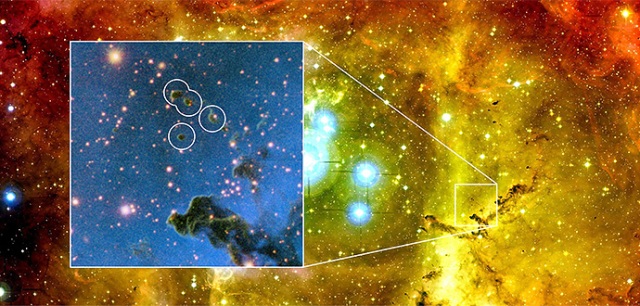Aug 20 2013
Tiny, round, cold clouds in space have all the right characteristics to form planets with no parent star. New observations, made with Chalmers University of Technology telescopes, show that not all free-floating planets were thrown out of existing planetary systems. They can also be born free.

Previous research has shown that there may be as many as 200 billion free-floating planets in our galaxy, the Milky Way. Until now scientists have believed that such “rogue planets”, which don’t orbit around a star, must have been ejected from existing planetary systems.
New observations of tiny dark clouds in space point out another possibility: that some free-floating planets formed on their own.
A team of astronomers from Sweden and Finland used several telescopes to observe the Rosette Nebula, a huge cloud of gas and dust 4600 light years from Earth in the constellation Monoceros (the Unicorn).
They collected observations in radio waves with the 20-metre telescope at Onsala Space Observatory in Sweden, in submillimetre waves with APEX in Chile, and in infrared light with the New Technology Telescope (NTT) at ESO’s La Silla Observatory in Chile.
”The Rosette Nebula is home to more than a hundred of these tiny clouds – we call them globulettes”, says Gösta Gahm, astronomer at Stockholm University, who led the project.
“They are very small, each with diameter less than 50 times the distance between the Sun and Neptune. Previously we were able to estimate that most of them are of planetary mass, less than 13 times Jupiter’s mass. Now we have much more reliable measures of mass and density for a large number of these objects, and we have also precisely measured how fast they are moving relative to their environment”, he says.
“We found that the globulettes are very dense and compact, and many of them have very dense cores. That tells us that many of them will collapse under their own weight and form free-floating planets. The most massive of them can form so-called brown dwarfs”, says team member Carina Persson, astronomer at Chalmers University of Technology.
Brown dwarfs, sometimes called failed stars, are bodies whose mass lies between that of planets and stars.
The study shows that the tiny clouds are moving outwards through the Rosette Nebula at high speed, about 80 000 kilometres per hour.
”We think that these small, round clouds have broken off from tall, dusty pillars of gas which were sculpted by the intense radiation from young stars. They have been accelerated out from the centre of the nebula thanks to pressure from radiation from the hot stars in its centre”, explains Minja Mäkelä, astronomer at the University of Helsinki.
According to Gösta Gahm and his team, the tiny dark clouds are being thrown out of the Rosette Nebula. During the history of the Milky Way, countless millions of nebulae like the Rosette have bloomed and faded away. In all of these, many globulettes would have formed.
“If these tiny, round clouds form planets and brown dwarfs, they must be shot out like bullets into the depths of the Milky Way”, says Gösta Gahm.
“There are so many of them that they could be a significant source of the free-floating planets that have been discovered in recent years”, he says.
Picture to the right: Astronomers have found that tiny, round, dark clouds called globulettes have the right characteristics to form free-floating planets. The graph shows the spectrum of one of the globulettes taken at the 20-metre telescope at Onsala Space Observatory. Radio waves from molecules of carbon monoxide (13CO) give information on the mass and structure of these clouds. ESO/M. Mäkelä
More about exoplanets and free-floating planets
Astronomers know of almost 900 planets which orbit around other stars than the Sun, but free-floating planets have also been found. Some have been discovered using a technique called microlensing, in which the planet is found when it passes in front of a background star, temporarily making it look brighter. This is an effect predicted by Einstein’s theory of general relativity, in which the light from the star is bent when the planet passes in front of it, a so-called gravitational lens. Scientists have estimated that the number of free-floating planets in our galaxy may exceed 200 billion.
More about the research
The study has been published in the article Mass and motion of globulettes in the Rosette Nebula in the July issue of the journal Astronomy & Astrophysics. The team consists of Gösta Gahm (Stockholm University, Sweden), Carina M. Persson (Onsala Space Observatory at Chalmers University of Technology, Sweden), Minja M. Mäkelä (Department of Physics, University of Helsinki, Finland) and Lauri K. Haikala (Finnish Centre for Astronomy with ESO [FINCA], University of Turku, Finland).
More about the telescopes
The team observed radio waves from molecules of carbon monoxide using the 20-metre radio telescope at Onsala Space Observatory, Sweden, and submillimetre light with the telescope APEX at 5100 metres altitude in the Atacama desert in northern Chile. APEX is a collaboration between the Max Planck Institute for Radio Astronomy in Bonn, Germany, Onsala Space Observatory and ESO, with operations of the telescope entrusted to ESO. Observations in infrared light were made using the 3.58 metre New Technology Telescope (NTT) at ESO’s La Silla Observatory.
More about Onsala Space Observatory
Onsala Space Observatory is Sweden's national facility for radio astronomy. The observatory provides researchers with equipment for the study of the earth and the rest of the universe. In Onsala, 45 km south of Gothenburg, it operates two radio telescopes and a station in the international telescope Lofar. It also participates in several international projects. The observatory is hosted by Department of Earth and Space Sciences at Chalmers University of Technology, and is operated on behalf of the Swedish Research Council.